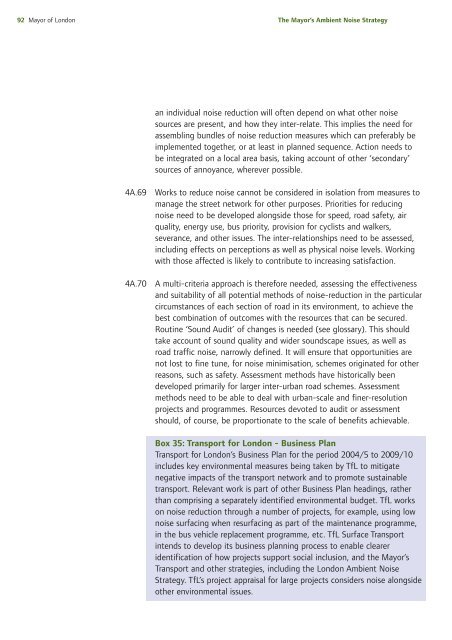The Mayor's Ambient Noise Strategy - Greater London Authority
The Mayor's Ambient Noise Strategy - Greater London Authority
The Mayor's Ambient Noise Strategy - Greater London Authority
Create successful ePaper yourself
Turn your PDF publications into a flip-book with our unique Google optimized e-Paper software.
92 Mayor of <strong>London</strong><br />
<strong>The</strong> Mayor’s <strong>Ambient</strong> <strong>Noise</strong> <strong>Strategy</strong><br />
an individual noise reduction will often depend on what other noise<br />
sources are present, and how they inter-relate. This implies the need for<br />
assembling bundles of noise reduction measures which can preferably be<br />
implemented together, or at least in planned sequence. Action needs to<br />
be integrated on a local area basis, taking account of other ‘secondary’<br />
sources of annoyance, wherever possible.<br />
4A.69 Works to reduce noise cannot be considered in isolation from measures to<br />
manage the street network for other purposes. Priorities for reducing<br />
noise need to be developed alongside those for speed, road safety, air<br />
quality, energy use, bus priority, provision for cyclists and walkers,<br />
severance, and other issues. <strong>The</strong> inter-relationships need to be assessed,<br />
including effects on perceptions as well as physical noise levels. Working<br />
with those affected is likely to contribute to increasing satisfaction.<br />
4A.70 A multi-criteria approach is therefore needed, assessing the effectiveness<br />
and suitability of all potential methods of noise-reduction in the particular<br />
circumstances of each section of road in its environment, to achieve the<br />
best combination of outcomes with the resources that can be secured.<br />
Routine ‘Sound Audit’ of changes is needed (see glossary). This should<br />
take account of sound quality and wider soundscape issues, as well as<br />
road traffic noise, narrowly defined. It will ensure that opportunities are<br />
not lost to fine tune, for noise minimisation, schemes originated for other<br />
reasons, such as safety. Assessment methods have historically been<br />
developed primarily for larger inter-urban road schemes. Assessment<br />
methods need to be able to deal with urban-scale and finer-resolution<br />
projects and programmes. Resources devoted to audit or assessment<br />
should, of course, be proportionate to the scale of benefits achievable.<br />
Box 35: Transport for <strong>London</strong> - Business Plan<br />
Transport for <strong>London</strong>’s Business Plan for the period 2004/5 to 2009/10<br />
includes key environmental measures being taken by TfL to mitigate<br />
negative impacts of the transport network and to promote sustainable<br />
transport. Relevant work is part of other Business Plan headings, rather<br />
than comprising a separately identified environmental budget. TfL works<br />
on noise reduction through a number of projects, for example, using low<br />
noise surfacing when resurfacing as part of the maintenance programme,<br />
in the bus vehicle replacement programme, etc. TfL Surface Transport<br />
intends to develop its business planning process to enable clearer<br />
identification of how projects support social inclusion, and the Mayor’s<br />
Transport and other strategies, including the <strong>London</strong> <strong>Ambient</strong> <strong>Noise</strong><br />
<strong>Strategy</strong>. TfL’s project appraisal for large projects considers noise alongside<br />
other environmental issues.
















